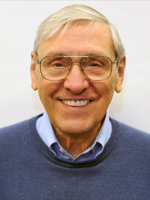Robin M. Hochstrasser
About Optica
In Memoriam: Robin M. Hochstrasser,
27 February 2013
In Memoriam: Robin M. Hochstrasser, 1931-2013
Robin M. Hochstr asser, an OSA fellow and a member of the Society since 1987, passed away on 27 February 2013 at the age of 82.
asser, an OSA fellow and a member of the Society since 1987, passed away on 27 February 2013 at the age of 82.
Hochstrasser, known as one of the world’s foremost scientists in the application of lasers in chemical and biomedical research, was a professor and distinguished researcher in the Department of Chemistry at the University of Pennsylvania in Philadelphia for the past 50 years.
In 1963, Hochstrasser brought modern research to the University of Pennsylvania with his work on how light interacts with molecules, a field known as molecular spectroscopy. His early work was concerned with the discovery of the spectroscopic properties of molecules in crystals subjected to high magnetic and electric fields and at low temperatures. In the late 1960s he, along with just a few other chemists worldwide, began to adapt various types of lasers for answering questions in chemistry and biology. This was the beginning of the “lasers in science” revolution that continues to this day. Quantitative studies of the ultrafast changes in molecular structure, particularly those of proteins, began with Hochstrasser’s research in the 1970s, which opened up the now flourishing field of time-resolved spectroscopy. Hochstrasser showed that laser studies of large molecules, such as proteins, can be carried out with the same rigor and depth as studies on small molecules. With the invention of femtosecond laser pulses (flashes of light of less than a trillionth of a second in duration), he exploited this new technology to develop highly sophisticated, so-called non-linear optical spectroscopic methods using multiple laser beams. His pioneering studies with femtosecond infrared pulses in the 1980s led to his development in the 1990s of a new kind of powerful spectroscopy, called two-dimensional infrared spectroscopy. This technique made it possible to make molecular movies of the three-dimensional structure of proteins in action with unprecedented time resolution, and defined a new role for ultrafast spectroscopic methods in chemistry, materials science, and biomedicine. Hochstrasser later used his invention to study human diseases, such as AIDS, Alzheimer’s disease, and influenza, by directly observing drugs interacting with their target proteins. His knowledge and expertise had a wide-ranging impact at the university in physics, chemistry, biology, and medicine.
Hochstrasser was born in Edinburgh, Scotland. He received his B.Sc. from Heriot-Watt University (1952) and his Ph.D. from the University of Edinburgh (1955). His thesis research was concerned with surface photochemistry, which aroused his interest in fundamental aspects of how light interacted with molecules. There was a small detour in his career for two years, when he was conscripted into the British Royal Air Force, where as a pilot officer he taught electronics to navigators so they could use and rapidly service new high altitude radar bombsights. In 1957 he joined the faculty at the University of British Columbia, and in 1963 he moved to the University of Pennsylvania, where he taught chemistry and carried out research for the next 50 years. At Penn he trained 75 Ph.D. students and more than 90 postdoctoral fellows. He published more than 500 original scientific papers and two books, Behaviour of Electrons in Atoms and Molecular Aspects of Symmetry.
Hochstrasser received OSA’s Ellis R. Lippincott Award in 1997 “for his seminal contributions to the development of modern ultrafast IR and visible laser techniques and their application to the study of condensed phase dynamics, including molecular energy transfer, structural change, and chemical reactions” and he was named an OSA Fellow in 1998. He was elected to the U.S. National Academy of Sciences in 1982 and received numerous other honors and awards throughout his career, including the Linus Pauling Award (2012), the Pittsburgh Spectroscopy Award (2010), Honorary Fellow, Royal Society of Edinburgh (2008), A. H. Zewail Award in Ultrafast Science and Technology (2007); F. Albert Cotton Medal, Texas A&M (2005); Benjamin Franklin Medal in Chemistry (2003); Centenary Silver Medal of the Royal Society of Chemistry (2000); E. Bright Wilson Award in Spectroscopy (1998); Ellis Lippincott Award of the Optical Society of America (1997); LICOR Award, University of Nebraska (1996); Peter Debye Award in Physical Chemistry (1996); National Institute of Health Merit Award (1990-2000); A.C.S. Philadelphia Section Award (1990); SPIE Special President's Award (1986); Heriot-Watt University, Scotland, D. Sc., (Honoris Causa) (1984); Fellow, American Academy of Arts and Sciences (1982); Bourke Medal, Faraday Society (1981); Alexander von Humboldt Senior Fellow (1978); American Physical Society, Fellow (1978); Alfred P. Sloan Foundation Fellow (1962-1967); John Simon Guggenheim Fellow (1972); Courtauld Scholar (1952-1955). He was to receive the Honorary degree of Doctor of Science from the University of Edinburgh on the occasion of the 300th anniversary of its School of Chemistry in June 2013.
Because of the depth and breadth of his research, Hochstrasser was widely regarded as a world leader in molecular spectroscopy who left his mark on science, not only by his own original research, but also by inspiring and creating many scientific opportunities for others. If one were to succinctly summarize his contributions to science, one would say that Hochstrasser, more than anyone else, developed and brought to bear modern laser methods to the study of the motions of molecules in solution.
Hochstrasser is survived by his wife, Carol Hochstrasser, a daughter and a grandchild.
If you would like to make a memorial donation to an OSA Foundation fund or endowment in honor of Robin M. Hochstrasser, please visit www.osa.org/donate.
This obituary was contributed by the University of Pennsylvania.
